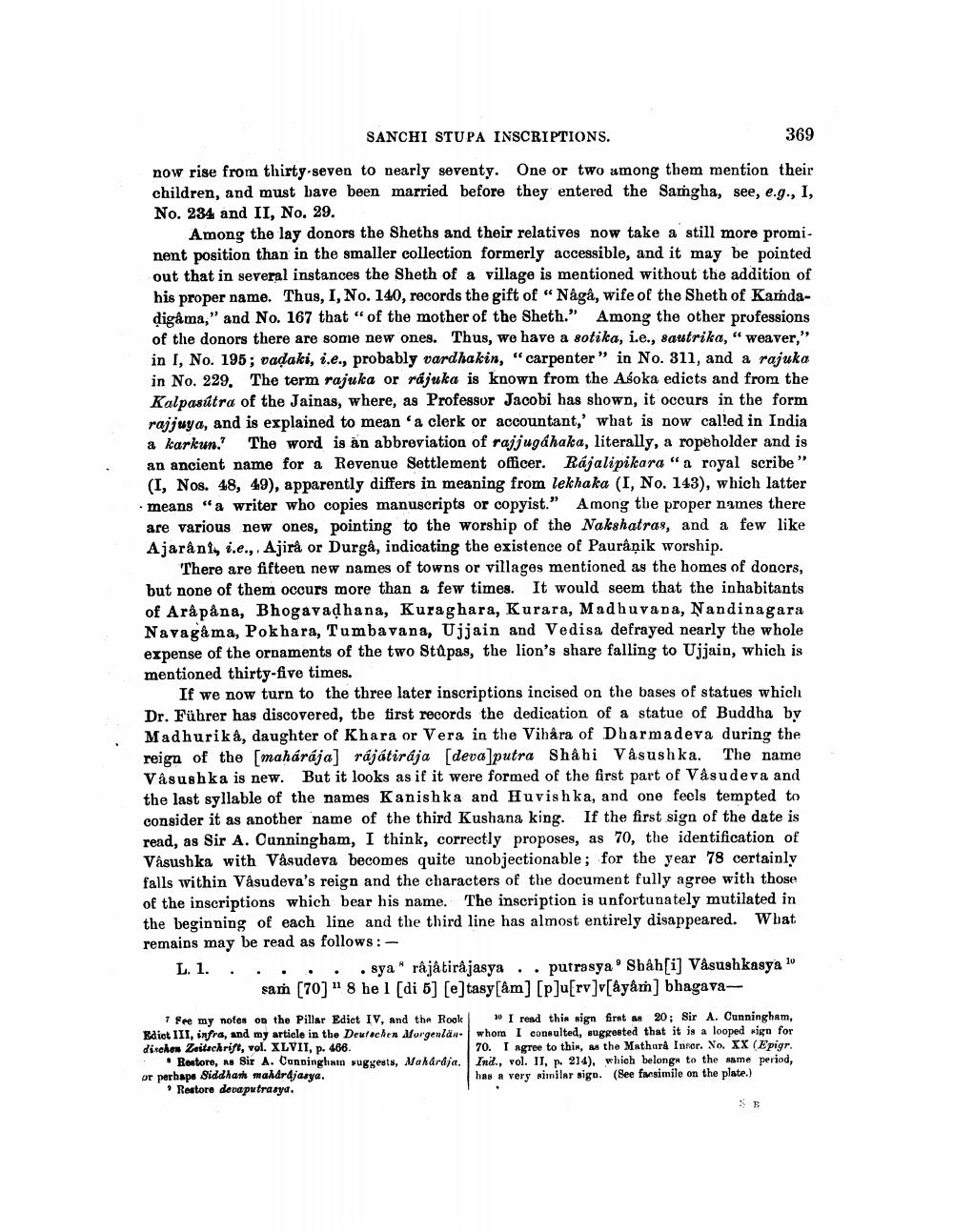________________
SANCHI STUPA INSCRIPTIONS.
369
now rise from thirty-seven to nearly seventy. One or two among them mention their children, and must bave been married before they entered the Samgha, see, e.g., I, No. 234 and II, No. 29.
Among the lay donors the Sheths and their relatives now take a still more promi. nent position than in the smaller collection formerly accessible, and it may be pointed out that in several instances the Sheth of a village is mentioned without the addition of his proper name. Thus, I, No. 140, records the gift of "Någå, wife of the Sheth of Kamdadigama," and No. 167 that "of the mother of the Sheth." Among the other professions of the donors there are some new ones. Thus, we have a sotika, i.e., sautrika, "weaver," in I, No. 195; vadaki, i.e., probably vardhakin, “carpenter" in No. 311, and a rajuka in No. 229. The term rajuka or rájuka is known from the Asoka edicts and from the Kalpasútra of the Jainas, where, as Professor Jacobi has shown, it occurs in the form rajjuya, and is explained to mean 'a clerk or accountant,' what is now called in India a karkun. The word is an abbreviation of rajjugáhaka, literally, a ropeholder and is an ancient name for a Revenue Settlement officer. Rajalipikara "a royal scribe" (I, Nos. 48, 49), apparently differs in meaning from lekhaka (I, No. 143), which latter means "a writer who copies manuscripts or copyist." Among the proper names there are various new ones, pointing to the worship of the Nakshatras, and a few like Ajarâni, i.e... Ajira or Durgå, indicating the existence of Paurâņik worship.
There are fifteen new names of towns or villages mentioned as the homes of doncrs, but none of them ocours more than a few times. It would seem that the inhabitants of Arâpåna, Bhogavadhana, Kuraghara, Kurara, Madhuvana, Nandinagara Navagama, Pokhara, Tumbavana, Ujjain and Vedisa defrayed nearly the whole expense of the ornaments of the two Stupas, the lion's share falling to Ujjain, which is mentioned thirty-five times.
If we now turn to the three later inscriptions incised on the bases of statues which Dr. Führer has discovered, the first records the dedication of a statue of Buddha by Madhurika, daughter of Khara or Vera in the Vihåra of Dharmadeva during the reign of the [mahárája] rájátirája [deva putra Shâ hi Vâsushka. The name Vâsushka is new. But it looks as if it were formed of the first part of Vasudeva and the last syllable of the names Kanishka and Huvish ka, and one feels tempted to consider it as another name of the third Kushana king. If the first sign of the date is read, as Sir A. Cunningham, I think, correctly proposes, as 70, the identification of Vâsushka with Vasudeva becomes quite unobjectionable ; for the year 78 certainly falls within Vasudeva's reign and the characters of the document fully agree with those of the inscriptions which bear his name. The inscription is unfortunately mutilated in the beginning of each line and the third line has almost entirely disappeared. Wbat remains may be read as follows:L. 1. . . . .. . sya" râjâtirajasya . . putrasya Shah[i] Våsushkasya 10
sam (70) " 8 he 1 [di 5] [e]tasy [am] [p]u[rv]vCâyår) bhagava1 See my notes on the Pillar Edict IV, and the Rook "I read thin sign first as 20; Sir A. Cunningham, Edict III, infra, and my article in the Deutschen Morgenlän- whom I consulted, suggested that it is a looped riga for dische Zeitechrift, vol. XLVII, p. 466.
70. I agree to thin, as the Mathura Inrer. No. XX (Epigr. Rostore, Sir A. Cunninghata suggests, Maharaja. Ind., vol. II, p. 214), which belongs to the same period, or perhaps Siddhan mahdr djasya.
has a very similar sigo. (See fusimile on the plate.) Restore deoa putrasya.




